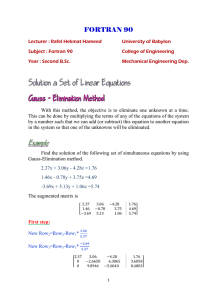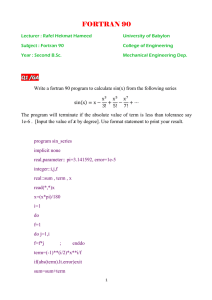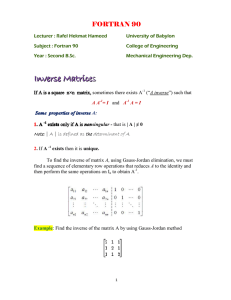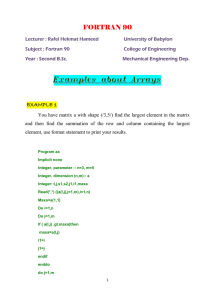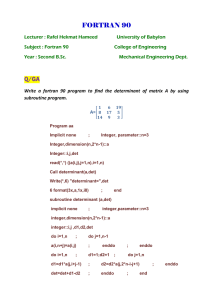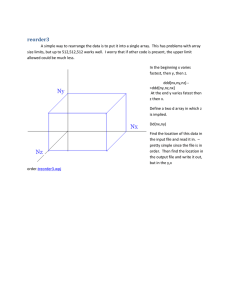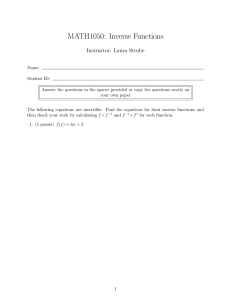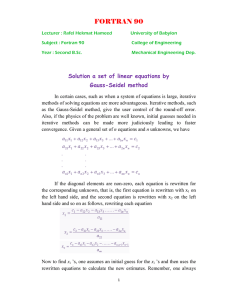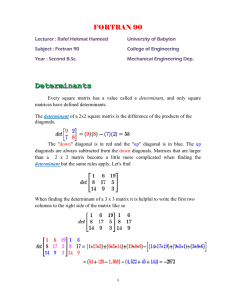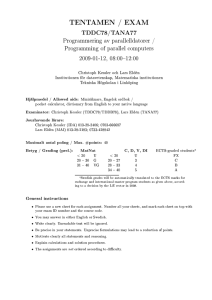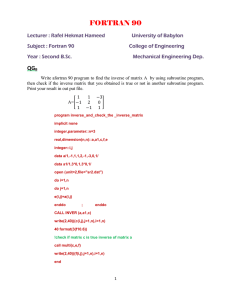FORTRAN 90 L e c
advertisement
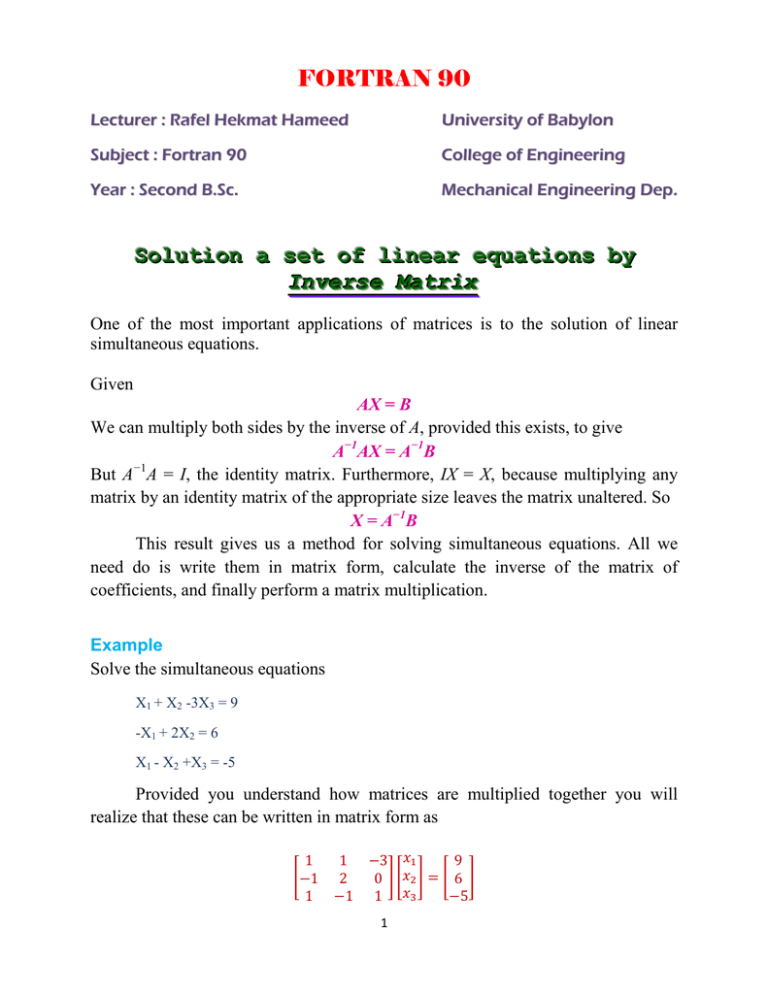
FORTRAN 90 Lecturer : Rafel Hekmat Hameed University of Babylon Subject : Fortran 90 College of Engineering Year : Second B.Sc. Mechanical Engineering Dep. SSoolluuttiioonn aa sseett ooff lliinneeaarr eeqquuaattiioonnss bbyy IInnvveerrssee MMaattrriixx One of the most important applications of matrices is to the solution of linear simultaneous equations. Given AX = B We can multiply both sides by the inverse of A, provided this exists, to give A−1AX = A−1B But A−1A = I, the identity matrix. Furthermore, IX = X, because multiplying any matrix by an identity matrix of the appropriate size leaves the matrix unaltered. So X = A−1B This result gives us a method for solving simultaneous equations. All we need do is write them in matrix form, calculate the inverse of the matrix of coefficients, and finally perform a matrix multiplication. Example Solve the simultaneous equations X1 + X2 -3X3 = 9 -X1 + 2X2 = 6 X1 - X2 +X3 = -5 Provided you understand how matrices are multiplied together you will realize that these can be written in matrix form as ͳ ͳ െ͵ ݔଵ ͻ ݔ െͳ ʹ ൩ ൩ ൌ Ͳ ଶ ൩ ݔ ଷ ͳ െͳ ͳ െͷ ϭ We need to calculate the inverse of A ͳȀ͵ A = ͳȀ െͳȀ -1 ͳȀ͵ ʹȀ͵ ͳȀ͵ ͳ ͳȀʹ൩ ͳȀʹ Then X is given by X = A−1B ͳȀ͵ = ͳȀ െͳȀ Ͳ = ͵ ൩ െʹ ͳȀ͵ ʹȀ͵ ͳȀ͵ ͳ ͻ ͳȀʹ൩ ቈ ͳȀʹ െͷ Hence X1= 0 , X2 =3 and X3= -2 is the solution of the simultaneous equations. A Fortran 90 program to solve a set of linear equations by using INVERSE MATRIX program solve_equations_by_inverse_matrix implicit none integer,parameter::n=3 real,dimension (n)::b,x real,dimension(n,n)::a,a1 integer::i,j,k,l real::z data a/1,-1,1,1,2,-1,-3,0,1/ data a1/1,3*0,1,3*0,1/ data b/9,6,-5/ !divided all elements of a & a1 by a(i,i) do i=1,n z=a(i,i) do j=1,n a(i,j)=a(i,j)/z a1(i,j)=a1(i,j)/z enddo !make zero all entries in column a(j,i) & a1(j,i) do j=i+1,n z=a(j,i) do k=1,n a(j,k)=a(j,k)-z*a(i,k) Ϯ a1(j,k)=a1(j,k)-z*a1(i,k) enddo enddo ; enddo !subtract appropiate multiple of row j from j-1 do i=1,n-1 do j=i+1,n z=a(i,j) do l=1,n a(i,l)=a(i,l)-z*a(j,l) a1(i,l)=a1(i,l)-z*a1(j,l) enddo enddo enddo do i=1,n write(*,60)(a(i,j),j=1,n) , (a1(i,j),j=1,n) 60 format(2x,3(f10.6),10x,3(f10.6)) enddo print*,"********************" CALL MULTI (a1,b,x) do i=1,n print 10,"x",i,"=",x(i) enddo 10 format(2x,a,i1,a,f10.5) end subroutine multi(a1,b,x) implicit none integer,parameter::n=3 real,dimension (n)::b,x real,dimension(n,n)::a1 integer::i,j,k do i=1,n do j=1,n x(i)=0 do k=1,n x(i)=x(i)+a1(i,k)*b(k) enddo;enddo;enddo end ϯ
